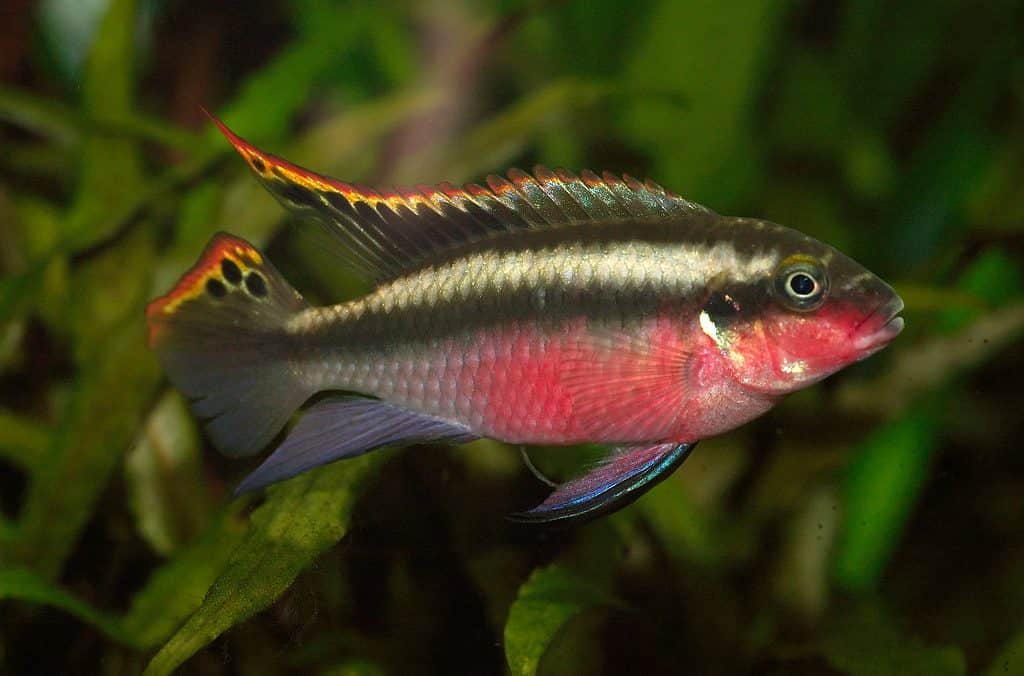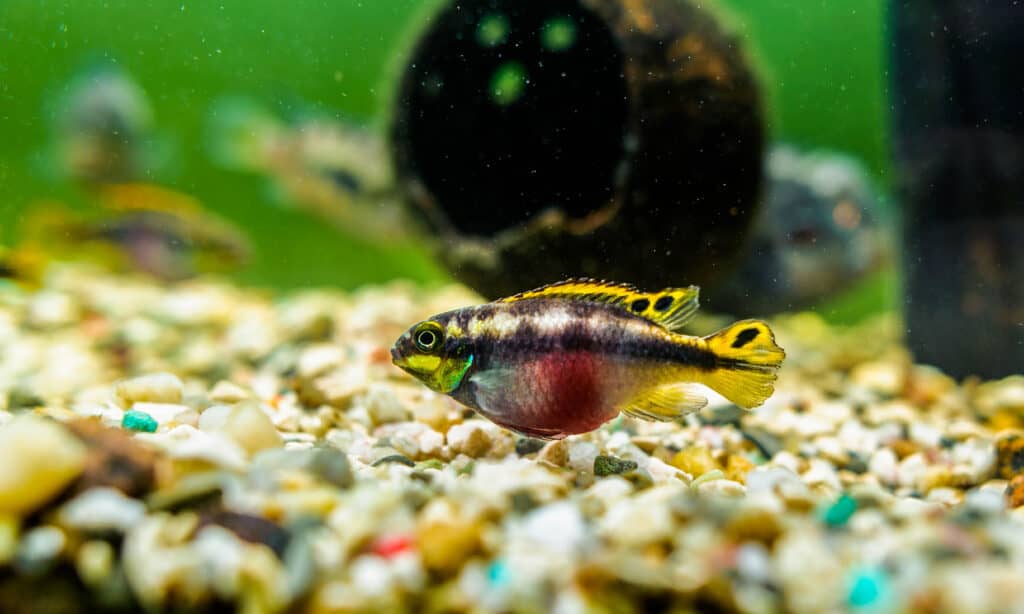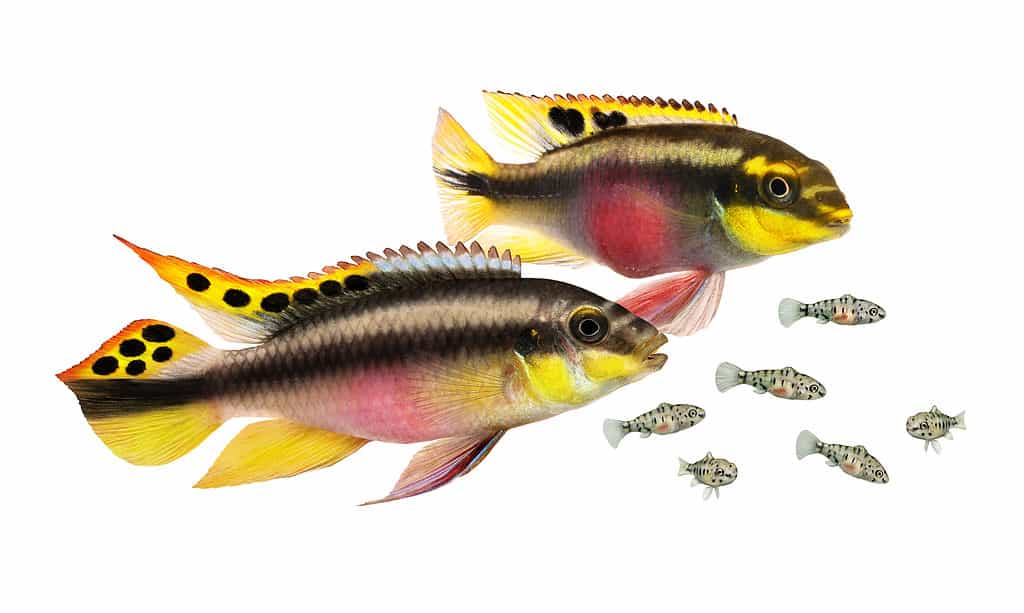Rainbow Kribs (Kribensis)
Pelvicachromis pulcher
Rainbow Kribs sometimes nip the fins of other fish, especially ones with long, flowing tails, which is too tempting for them not to bite.
Advertisement
Rainbow Kribs (Kribensis) Scientific Classification
- Kingdom
- Animalia
- Phylum
- Chordata
- Class
- Actinopterygii
- Order
- Perciformes
- Family
- Cichlidae
- Genus
- Pelvicachromis
- Scientific Name
- Pelvicachromis pulcher
Read our Complete Guide to Classification of Animals.
Rainbow Kribs (Kribensis) Conservation Status
Rainbow Kribs (Kribensis) Facts
- Prey
- Shrimp, Crustaceans, Worms, and insects
- Name Of Young
- Fry
- Group Behavior
- Territorial
- Fun Fact
- Rainbow Kribs sometimes nip the fins of other fish, especially ones with long, flowing tails, which is too tempting for them not to bite.
- Biggest Threat
- Habitat loss
- Other Name(s)
- Niger cichlid, Purple cichlid, Kribensis, Platte cichlid
Rainbow Kribs (Kribensis) Physical Characteristics
- Aggression
- High
View all of the Rainbow Kribs (Kribensis) images!
These magnificent fish are often referred to as Krib, but they go by many names, including cichlid or kribensis. The West African cichlid’s present scientific name is Pelvicachromis pulcher, meaning beautiful bellied fish.
Cichlids are surprisingly resilient against disease; if owners care for them properly, they can live up to 5 years old! In addition, these mesmerizing fish barely need any coaxing to mate. Rainbow kribs have really strange parenting skills and will herd their offspring around the aquarium for several weeks.
Rainbow Krib History and Origin
Rainbow kribs have 2 scientific names Pelviacavhromos taeniatus and Pelvicachromis pulcher, and there is still a debate over which species is which. But people in the aquarium trade have bestowed the name Pelvicachromis pulcher on these gorgeous creatures.
These fish originate from freshwater bodies in Nigeria, Cameroon, and Sierra Leone, where various water conditions exist. Rainbow kribs prefer brackish water with a more alkaline content, which is why some call it the brackish-water fish. However, when the water’s chemistry starts to change, kribs will begin to stress and, in turn, contribute to disease.
Christian Bruening was the first person to import these magnificent fish to Germany in 1913, and since then, they have acquired many names, including:
- Niger cichlid
- Purple cichlid
- Kribensis
- Platte cichlid
Interestingly, almost all rainbow krib sold in the aquarium trade are captive-bred; it is very rare to obtain a wild-caught specimen.

The fins of male rainbow kribs are long and pointed, especially the dorsal fin, which is curved dramtically, leaning towards the back of the body.
©Tino Strauss, CC BY-SA 3.0 <http://creativecommons.org/licenses/by-sa/3.0/>, via Wikimedia Commons – License
Three Amazing Rainbow Krib Facts!
- Rainbow kribs can live up to five years old
- Telling them apart is easy; female kribs are noticeably smaller than males, and their coloring is brighter and more impressive. In addition, female fins are rounded, while males are pointed.
- Cichlids are protective of their eggs and fry, but as the next mating season approaches, they will stop caring for their fry and focus on the new eggs being laid. During this time, it is not uncommon for the rainbow krib parents to eat their fry.
Rainbow Krib Scientific Name
There is a debate over the scientific name of Rainbow Kribs. Some researchers refer to this species as Pelvicachromis taeniatus, while in the aquarium trade, they are known as Pelvicachromis pulcher.
Rainbow Krib Appearance
The rainbow krib has that familiar cichlid profile, which includes a slim shape, tall height, and rounded head. In addition, these exotic fishes have a lot going on in terms of coloring, which varies from gray to white. Their base color is accented by a pronounced black stripe running from their eyes to their tail. Also, these fish might sport some black coloration on the top of their heads.
However, the most distinguishable feature of the female rainbow kribs is their reddish-pink bellies. And, during mating season, their red bellies become more vibrant to attract a male, who don’t share this pink hue with the females but have interesting fins.
The fins of male kribs are long and pointed, especially the dorsal fin, which is also curved in a dramatic point, leaning towards the back of the body. Both male and female cichlids have dorsal and tail fins with yellow and red borders.
In addition, many rainbow kribs have black dots on their dorsal and tail fins, mimicking eyes that serve as a defense mechanism. Furthermore, they may have long pelvic fins decorated with metallic blue streaks.

Female rainbow kribs are noticeably smaller than males, have rounded fins and their coloring is brighter and more impressive.
©zzphot_25/Shutterstock.com
Rainbow Krib Behavior
The rainbow krib is a peaceful and non-aggressive fish. They are a great addition to aquariums containing mild-mannered species and can easily acclimate to living with others. However, they do sometimes nip the fins of other fish, especially ones with long, flowing tails, which is too tempting for them not to bite.
These fish may become territorial when mating season comes around, and owners notice an increase in disputes around the caves in their aquariums around this period. Therefore, they should never inhabit the same tank as other cave-dwelling species, as they will likely fight over the area.
Rainbow Krib Habitat
Kribensis cichlids inhabit various rivers and deltas in West Africa, in countries like Nigeria, Cameroon, and Sierre Leone. These freshwater habitats vary in hardness, pH levels, and salinity levels. However, some rainbow kribs originate from brackish water, while others prefer soft, black bodies of water.
Their ideal habitat is slow-moving waters filled with vegetation. However, keeping one of these gorgeous fish is much easier as they have been domesticated for decades and adapted to all sorts of conditions.
Rainbow Krib Diet
Pet stores generally refer to all Pelvicachromis species as omnivores. Still, they mainly consume plant matter and enjoy the taste of algae, and they usually have a fair amount of sand in their bellies, suggesting they sift through the dirt in search of food.
In the wild, rainbow krib’s diet consists of crustaceans, worms, and insects, but mainly they consume leaf and stem fragments.
What shocked scientists were the amount of algae these fish can ingest. They seem to gravitate more to:
- Diatomaceous algae
- Blue-green algae
- Plain green algae
While the sand in their bellies makes it clear they ingest it as they sift around for detritus and algae, researchers also believe that they can digest the nutritious biofilm that covers individual grains of sand.
When in captivity, these fish should have a diet mainly consisting of plant-based foods, and they will eventually pick apart the softer-leafed plants in the tank. But, always be sure to check the ingredients of any plant-based food or algae flakes because sometimes, they don’t contain much greenery at all, and the main ingredient is fish, which is not suitable for their diet.
So, in a perfect world, owners should feed their rainbow kribs veggie-packed flakes that won’t distort or stunt their growth. Fish enthusiasts can also supplement these flakes with greens such as dandelions, blanched spinach, seaweed products, and flaked peas.
Rainbow Krib Predators and Threats
Because rainbow kribs are so small, they have many natural predators, primarily larger fish like the Nile perch (Lates niloticus). So, when these stunning fish feel threatened, they will often hide in cave systems or aquatic vegetation to eliminate detection.
The rainbow kribs’s biggest threats are pollution and habitat loss due to:
- Mining
- Quarrying
- Logging
- Wood harvesting
However, these fish are listed as Least Concern on IUCN’s Redlist, so at the moment, there are no measures in place to protect them.
Rainbow Krib Reproduction, Babies, and Lifespan
Rainbow kribs are relatively easy to breed in captivity, and unlike most fish species, they have powerful parental instincts. However, experts recommend a separate breeding tank to ensure the fry survives.
The perfect temperature for this tank is 80°F; by setting the temperature in this vicinity, there is a bigger chance of a larger clutch. In addition, the pH level should be around 7.0.
Lastly, before introducing the bonded pair, add fine gravel as a substrate and insert a spacious and private cave. Owners can condition this couple with live foods, which will also keep them stimulated. Once comfortable, the female will start showing signs she is ready to mate. These signs can include a bright red belly swelling up with eggs.
Both male and female rainbow kribs will start exhibiting strange behaviors during this time. Firstly, they will choose a cave or hiding spot and start to clear it out, making space for the eggs. Then, once the male krib fertilizes the eggs, the females can lay a clutch of between 200 to 300 eggs!
Babies
Interestingly, she won’t leave her eggs until they hatch, and the male won’t go far either, as he needs to guard the cave. It can take 2-5 days for the eggs to hatch, at which point the fry will start to eat their egg sac.
Once the fry becomes free-swimming, they won’t leave their parents’ sides. These tiny fry can live off a diet of infusoria, liquid fish food, and powered fish food. Offspring can stay with their parents until they lay eggs again, but if they display any signs of aggression, it’s best to move the parents to a different tank.

Rainbow kribs have powerful parental instincts staying with their eggs until they hatch and keeping her young close until more eggs are laid.
©iStock.com/Mirko_Rosenau
Lifespan/Longevity
Rainbow kribs have a relatively long lifespan if cared for properly; they can live up to 5 years old.
Rainbow Krib Population
Unfortunately, because of all the captive rainbow kribs, it’s tough to get an accurate reading on population size, but they are not endangered now.
Rainbow Krib Care
Caring for this magnificent fish is relatively easy. However, owners need to ensure they are following some basic care guidelines.
How Many Rainbow Kribs per Gallon?
The minimum tank size requirement for two cichlids is 20 gallons, but a 30 to 50-gallon tank is preferred. By providing them with more space, they can set up a territory, and it could contribute to tranquil coexistence between the fish.
Is it Ok to Keep a Single Rainbow Krib?
Rainbow kribs are fine living on their own. However, they might not show off their best colors or most active behaviors when alone.
Rainbow Krib Tank Setup
These stunning fish need a few things to make their lives more comfortable in an aquarium, including:
Decorations
The bottom of the tank needs fine gravel substrate or dark-colored sand. In addition, owners should add plenty of live plants. Ensure these plants are adequately secured, as rainbow kribs love to dig and can easily uproot them if they are loose.
The best plants to use are ones that can tolerate low light conditions like:
- Java moss
- Ferns
- Hornworts
- Anubias
Lastly, these active little fish needs plenty of hiding spaces. This can include pots, driftwood, rocks, and smooth-sided caves. But, they need to be placed on the outer edges of the tank, far from each other, so that the rainbow kribs can form various territories.

Rainbow krib owners should add plenty of live well-secured plants into their aquarium.
©Aleron Val/Shutterstock.com
Water Temperature and pH Level
While rainbow kribs are adaptable little creatures, they still need suitable conditions to thrive in their aquarium. Changes in water conditions can cause stress among these fish and make them vulnerable to disease.
The temperature of their tank’s water needs to range between 75 to 79 degrees Fahrenheit. In addition, the pH level should lean toward neutral but can range from 5.0 to 8.0. Finally, the water hardness should fluctuate between 5 to 20 dGH.
Filters, Heaters, and Thermometers
Rainbow kribs are extremely sensitive to an increase in ammonia and nitrates, so their tank will need a robust filtration system.
The best filters are hang-on-backs or canisters with the ability to turn over the water often, and they should effectively eliminate contaminants while keeping a gentle current. In addition, there are many quality test kits owners can buy that can monitor water conditions. Furthermore, use low-powered lights, as this species does not like bright lights.
Lastly, investing in a good heater and thermometer will help you monitor the tank’s conditions and ensure everything runs at the optimum range.
What Species Can Rainbow Kribs Live With?
Cichlids must live with the same species or fish of a similar temperament and size. In addition, kribs are very territorial over their hiding spots, so keeping too many males in one tank is not a good idea, especially during mating season.
Suitable tankmates include:
- Cherry or Tiger Barbs
- Harlequin rasboras
- Zebra Danios
- Tetras
- Plecos
- Gouramis
- Catfish
However, avoid housing them with larger, more aggressive cichlids, crayfish, and shrimp.
Does Rainbow Krib Eat their Fry?
While these fish are unusually tentative parents, they will eat their own fry if these juveniles stick around once new eggs are laid.
Related Animals
View all 114 animals that start with RRainbow Kribs (Kribensis) FAQs (Frequently Asked Questions)
How big do rainbow kribs get?
Males can reach a length of 4 inches, while females generally grow to 3 inches long.
What fish can live with kribs?
Suitable tankmates include:
• Cherry or Tiger Barbs
• Harlequin rasboras
• Zebra Danios
• Tetras
• Plecos
• Gouramis
• Catfish
How many Kribensis can I keep together?
The minimum tank size requirement for two cichlids is 20 gallons, but a 30 to 50-gallon tank is preferred. By providing them with more space, they can set up a territory, and it could contribute to tranquil coexistence between the fish.
Thank you for reading! Have some feedback for us? Contact the AZ Animals editorial team.
Sources
- Fish Tank Advisor, Available here: https://fishtankadvisor.com/kribensis-cichlid/#Appearance_and_Biology
- Aquarium Source, Available here: https://www.aquariumsource.com/kribensis-cichlid/
- Build Our Aquarium, Available here: https://www.buildyouraquarium.com/kribensis-cichlid/
- Aquadaise, Available here: https://www.aquariadise.com/kribensis/

















